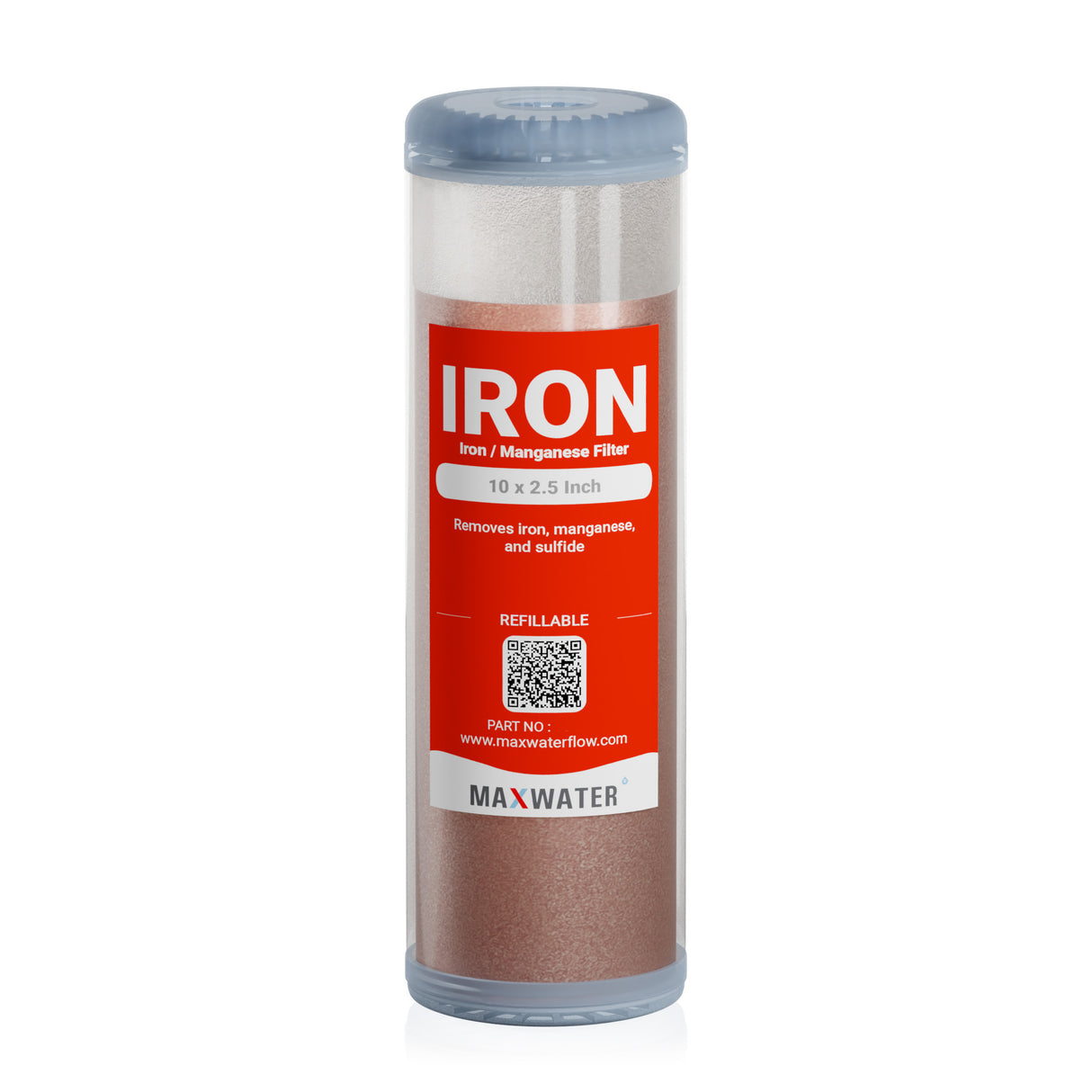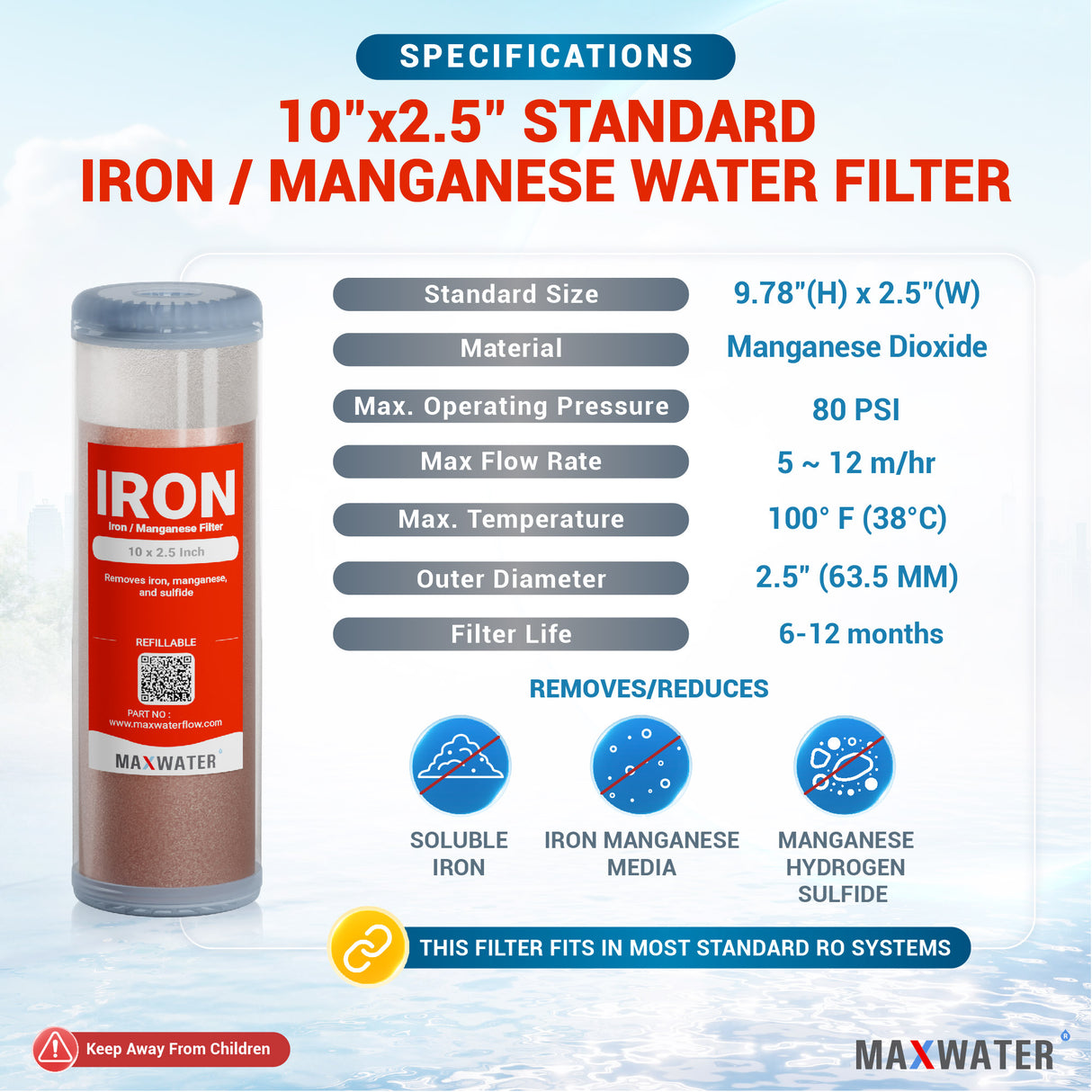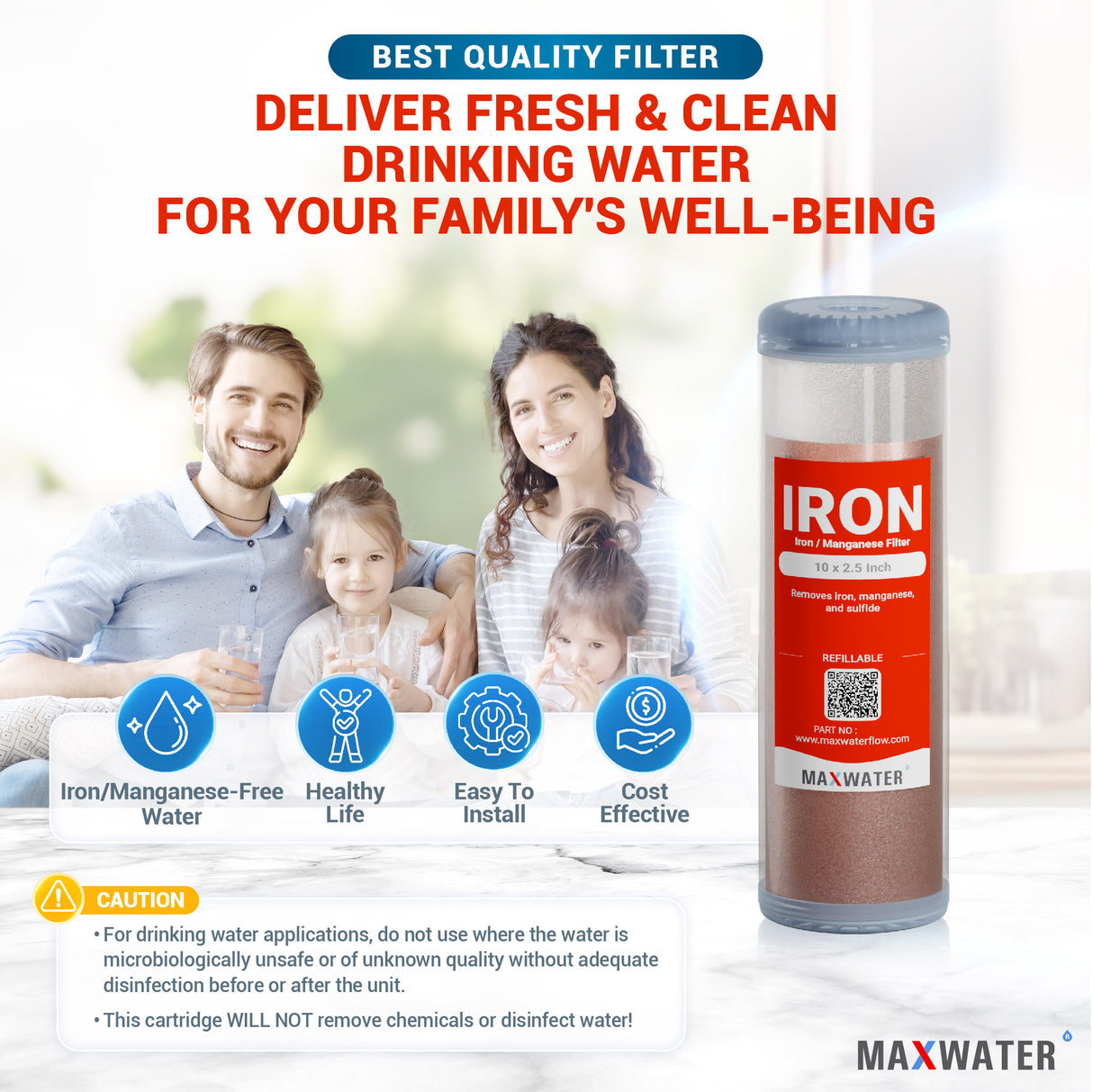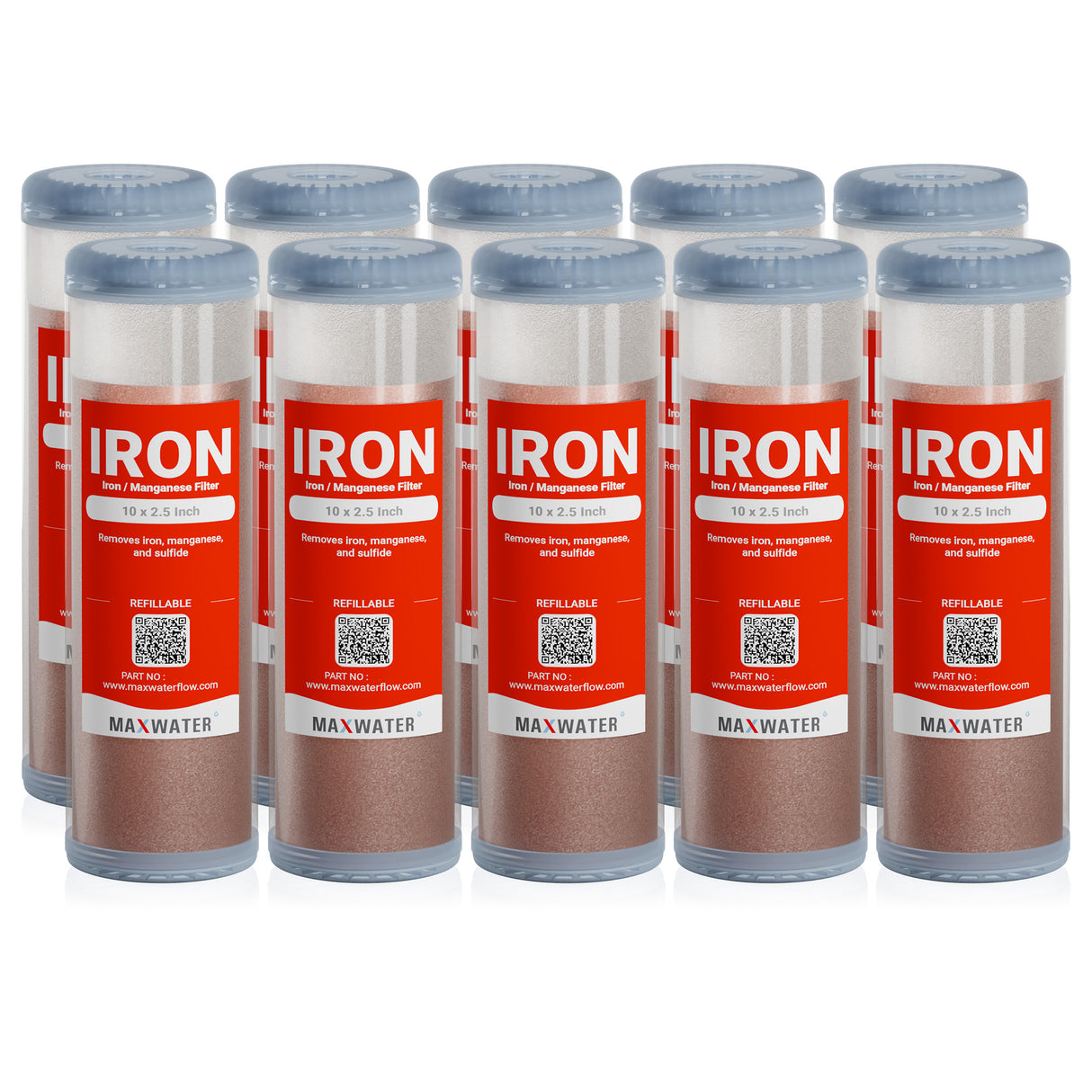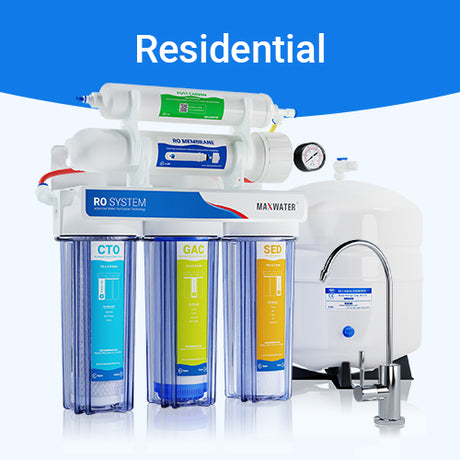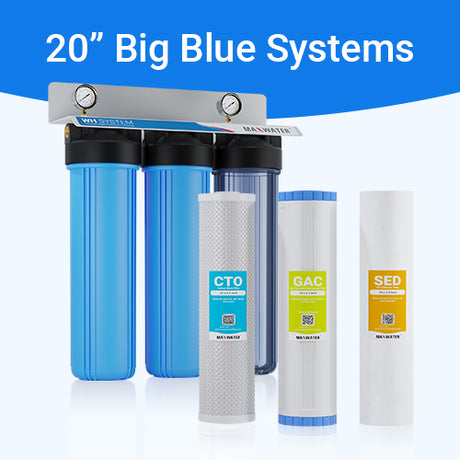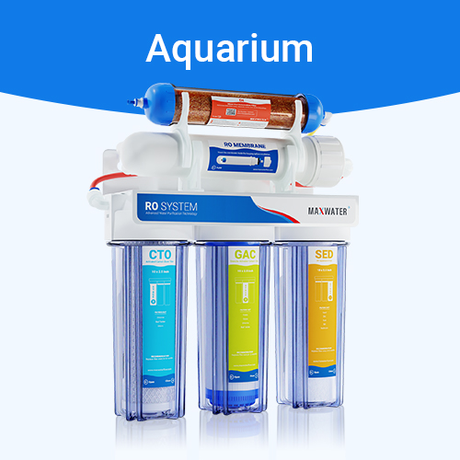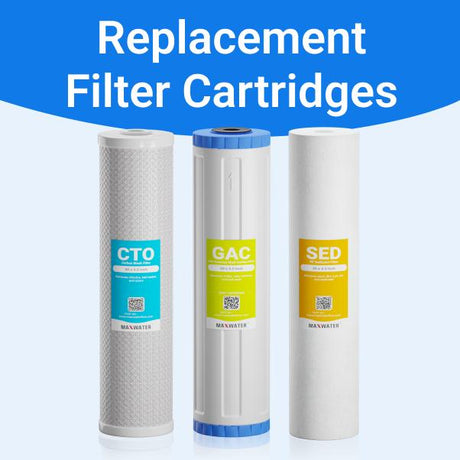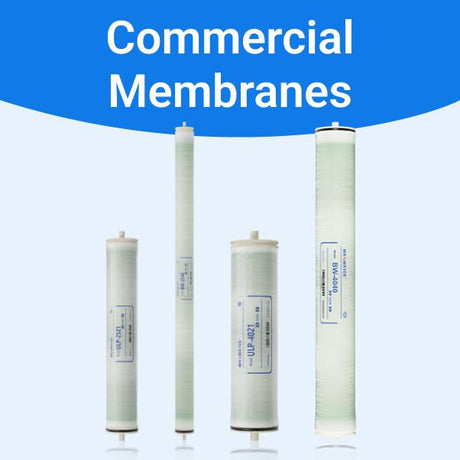Iron/Manganese Reduction Filter Cartridge (Refillable) for Whole House System, Size - 10" x 2.5"
Iron/Manganese Reduction Filter Cartridge (Refillable) for Whole House System, Size - 10" x 2.5" - 1 Pack is backordered and will ship as soon as it is back in stock.
Description
Description
Shipping & Returns
Shipping & Returns
Shipping
We currently ship to the United States and Canada. To enquire about shipping to a different destination, please contact us.
Standard shipping normally takes 3-9 days. Next-day shipping is available on all domestic orders (for an additional charge). International shipping times depend on the products and destination (estimated at checkout).
Returns
Items must be returned within 30 days after receiving your order. Items must be returned in the same condition in which they were received, be unworn/unused, have any tags still attached, and include all the original packaging.
Please be aware that the seller will not cover the cost of the return label. It is the customer's responsibility to generate the return shipping label and send the system back to our warehouse.
Refunds
Refunds are processed within 7 days from when we receive the item(s).
Join and get free shipping on orders over $100
First-time purchasers will receive a special discount code sent to their email.
10-inch x 2.5-Inch Standard Iron/Manganese Filter (Refillable):
Iron manganese media serves as an effective solution for eliminating soluble iron (Fe), manganese (Mg), and hydrogen sulfide (H2S) from well water sources. This purple-black filter media is derived from processed ceramic zeolite granules. Its application can be in a fully enclosed pressure system without the need for aeration or re-pumping, or alternatively, in an open gravity filter system.
Various operational methods exist, with continuous regeneration being the recommended approach for water primarily contaminated with iron.
Important Considerations: It is advisable for customers to incorporate a "sediment filter" as a pre-filter and a "CTO filter" as a post-filter. This precautionary measure enhances the longevity of the "Iron Manganese" replacement cartridge, as the Iron-Manganese filter weave can become quickly obstructed without the protection of a sediment filter. Additionally, users may observe a minor decrease in water output pressure (the iron-manganese system requires a minimum inlet pressure of 60 psi). This is a normal aspect of the media cartridge's functioning.
Physical Attributes
- Apparent Density: 1.0 g/ml
- Shipping Weight: 1.05 Lbs
- Specific Gravity: 2.5~2.6
- Screen Grading (dry): 16~30 mesh
- Effective Size: 0.65 ± 0.05mm
- Uniformity Coefficient: Less than 1.5
- pH Range: 6.2 ~ 8.5
- Maximum Temperature: 25 C°
- Maximum Pressure Drop: 0.85 kg/cm2
Methods of Operation
For wells primarily focused on iron removal, especially with or without the presence of manganese, the recommended mode of operation is continuous regeneration. In this process, a predetermined quantity of potassium permanganate (KMnO4), often combined with chlorine (Cl2), is introduced directly into the untreated water prior to the unit containing Iron manganese for continuous regeneration. It is advisable to feed chlorine upstream of KMnO4, allowing for a contact time of 10 to 20 seconds if possible. Sufficient chlorine should be administered to achieve the desired residual in the filter effluent. The introduction of KMnO4 should be ample to produce a "just pink" color in the filter inlet, ensuring the continuous regeneration of the Iron manganese media.
The quantity of Cl2 and KMnO4 required can be estimated as follows:
mg/L KMnO4 = (0.2 x mg/L Fe)(2 x mg/L Mn)
Without Cl2 the KMnO4 demand can be estimated as follows:
Suggested Operating Conditions
- Backwash: Employ a sufficient rate using treated water to achieve an approximate 30% expansion of the bed.
- Rinse: Conduct a rinse at the normal service flow rate for a duration of 5 minutes or until the effluent meets acceptable standards.
- Capacity: The capacity ranges from 350 to 500 g/m2 of bed area, based on the demand for potassium permanganate. For continuous regeneration of iron/manganese, a minimum bed height of 70cm composed of specially sized iron/manganese media is essential. The pressure drop should not surpass 0.70 to 0.85 kg/cm2.
- Flow rate: In continuous regeneration operation, maintain normal flow rates within the range of approximately 5 to 12 m/hr. Higher concentrations of iron and manganese typically necessitate lower flow rates for equivalent run lengths. While rates exceeding 12 m/hr can generally be tolerated, it is recommended to operate a pilot unit to assess effluent quality and run length.
The run length between backwashes can be estimated as follows:
Example:What is run length on a water containing 1.7 mg/L iron and 0.3 mg/L manganese at 10m/hr operating rate?
=(1 x 1.7) + (2 x 0.3)
= 2.3 mg/L
At 500 g/m2 loading ÷ 2.3 mg/L = 217 m
At 10 m/hr service rate, 217/10 = 21.7 hr
Therefore the backwash frequency is approximately every 20 ~ 24 hours of operation.
General Notes
pH Considerations:Raw water with a pH of 6.2 or higher can traverse through iron/manganese media without necessitating pH correction. However, water with a pH lower than 6.2 should undergo pH adjustment to fall within the range of 6.2 to 6.5 before passing through the iron/manganese media. If a pH exceeding 6.5 is desired in the water system, any additional alkali should be introduced after the filters. This precaution is taken due to the potential adverse reactions involving a colloid that may occur with both iron and alkali when the pH surpasses 6.5.
KMnO4 Solution Strength:In continuous regeneration operation, the concentration of KMnO4 can be as high as 30 g/L.
Solubility of KMnO4 in Water:
| Temp. C° | g/100 ml |
|---|---|
| 0 | 2.78 |
| 20 | 6.51 |
| 40 | 12.53 |
Estimated Life of WH5 Iron filter Cartridge for 20" x 4.5" Cartridge:
If you have a 10"x4.5" OR 20" x 2.5" cartridge, divide by 4.
If you have a 10"x2.5" cartridge, divide by 8.
| Iron Equivalent Level in Water | Total Gallons Water Used | 250 GPD (946 LPD)(four people) | 125 GPD (473 LPD)(two people) | 75 GPD (284 LPD)(one person) |
|---|---|---|---|---|
| 0.5 ppm | 160,000 gal (605,670 L) | 640 days | 1280 days | +2,000 days |
| 1 ppm | 80,000 gal (302,830 L) | 320 days | 640 days | 1280 days |
| 2 ppm | 40,000 gal (151,420 L) | 160 days | 320 days | 640 days |
| 3 ppm | 26,000 gal (98,420 L) | 104 days | 208 days | 416 days |
| 4 ppm | 20,000 gal (75,710 L) | 80 days | 160 days | 320 days |
| 5 ppm | 16,000 gal(60,570 L) | 64 days | 128 days | 256 days |
Material Safety Data Sheet
Hazards Identification
- Inhalation: Elevated concentrations of a nuisance dust can lead to conditions such as coughing, sneezing, and nasal irritation.
- Ingestion: Considered non-toxic; however, significant oral doses may result in irritation to the gastrointestinal tract.
- Skin Contact: Unlikely to pose a health hazard through skin exposure, though it may cause mild irritation and redness.
- Eye Contact: Although specific information is not available, it is presumed to cause mechanical irritation.
- Aggravation of Pre-existing Conditions: No relevant information is available.
First Aid Measures
- Inhalation: Move to an area with fresh air. Seek medical attention if experiencing difficulty breathing.
- Ingestion: First aid measures are not typically necessary. In the case of significant ingestion, provide water to drink and consult with medical professionals.
- Skin Contact: Promptly rinse the affected skin with abundant water for at least 15 minutes. Remove contaminated clothing and footwear. Launder clothing before reuse and thoroughly clean footwear before wearing again. Seek medical attention if irritation develops.
- Eye Contact: Immediately flush the eyes with ample water for at least 15 minutes, intermittently lifting upper and lower eyelids. If irritation persists, seek medical attention.
Fire Fighting Measure
- Fire: Deemed not to pose a fire hazard.
- Explosion: Not identified as an explosion hazard.
- Fire Extinguishing Media: Utilize any appropriate method to extinguish the adjacent fire.
- Special Information: In the event of a fire, wear complete protective clothing and use a NIOSH-approved self-contained breathing apparatus with a full facepiece, operated in the pressure demand or other positive pressure mode.
Accidental Release Measure
- Ventilate the area affected by the leak or spill. Use the suitable personal protective equipment outlined in Section 8. For spills, gather the material by sweeping and place it in a container for reclamation or proper disposal. Consider using vacuuming or wet sweeping methods to prevent the dispersal of dust.
Handling and Storage
- Store in a tightly sealed container, in a cool, dry, well-ventilated space, and safeguard against physical harm. Empty containers may pose hazards due to retained product residues (such as dust or solids), so adhere to all warnings and precautions outlined for the product.
- Personal Respirators(NIOSH Approved): For instances where the exposure limit is surpassed, and engineering controls are impractical, individuals can use a half-facepiece particulate respirator (NIOSH type N95 or superior filters) for a duration of up to ten times the exposure limit or the maximum use concentration specified by the relevant regulatory agency or respirator supplier, choosing the lower value. Alternatively, a full-facepiece particulate respirator (NIOSH type N100 filters) may be worn for up to 50 times the exposure limit or the maximum use concentration specified by the appropriate regulatory agency or respirator supplier, again opting for the lower value. If there are oil particles present (such as lubricants, cutting fluids, glycerine, etc.), it is advisable to use a NIOSH type R or P filter. In situations of emergencies or when exposure levels are unknown, opt for a full-facepiece positive-pressure, air-supplied respirator.
- Skin Protection: Wear protective gloves and clean body-covering clothing.
- Eye Protection: Use chemical safety goggles. Maintain eye wash fountain and quick-drench facilities in work area.
- Appearance: Black Nodular Granules, Sand-like in Appearance
- Odor: No Odor
- Boiling Point: None
- Specific Gravity: 2.6
- Vapor Pressure: N/A
- Percent Volatile by Volume: None
- Solubility in Water: 0%
- Vapor Density: N/A 10.
- Stability: Stable under ordinary conditions of use and storage.
- Incompatible Material: Avoid contact with hydrochloric acid as gaseous chlorine may be produced.
- Hazardous Polymerization: Will not occur.
- Incompatibilities: Strong acids, fluorine, ammonium salts, magnesium with hydrogen.
- Conditions to Avoid: Avoid contact with concentrated hydrochloric acid (HCl).
- Effects of Overexposure: Inhalation – normal nuisance dust symptoms
- Eye Contact: Will act as irritant
- Ingestion: Non – toxic
- Skin Contact: No acute effects
- Threshold Limit Value: None
- Environmental Fate: No information found
- Environmental Toxicity: No information found
- Items that cannot be salvaged for recovery or recycling should be handled at a suitable and authorized waste disposal facility. The options for waste management may be influenced by the processing, use, or contamination of this product. It is essential to recognize that state and local disposal regulations might vary from federal disposal regulations. Dispose of the container and any unused contents in compliance with the relevant federal, state, and local requirements.
- Transport Information: Not regulated
- Regulation Information: Not regulated
- The information presented is offered in good faith and reflects our current knowledge.
- This document is not intended as a technical guide for product usage.
- The user is not relieved of the responsibility to be familiar with and adhere to all applicable regulations and to implement all pertinent safety measures.
Exposure Controls and Personal Protection
WARNING: Air-purifying respirators do not protect workers in oxygen-deficient atmospheres.
Physical and Chemical Properties/ Characteristics
Stability and Reactivity
Toxicological Information
Ecological Information
Disposal Information
Important NOTE
10-inch x 2.5-Inch Standard Iron/Manganese Filter (Refillable):
Iron manganese media serves as an effective solution for eliminating soluble iron (Fe), manganese (Mg), and hydrogen sulfide (H2S) from well water sources. This purple-black filter media is derived from processed ceramic zeolite granules. Its application can be in a fully enclosed pressure system without the need for aeration or re-pumping, or alternatively, in an open gravity filter system.
Various operational methods exist, with continuous regeneration being the recommended approach for water primarily contaminated with iron.
Important Considerations: It is advisable for customers to incorporate a "sediment filter" as a pre-filter and a "CTO filter" as a post-filter. This precautionary measure enhances the longevity of the "Iron Manganese" replacement cartridge, as the Iron-Manganese filter weave can become quickly obstructed without the protection of a sediment filter. Additionally, users may observe a minor decrease in water output pressure (the iron-manganese system requires a minimum inlet pressure of 60 psi). This is a normal aspect of the media cartridge's functioning.
Physical Attributes
- Apparent Density: 1.0 g/ml
- Shipping Weight: 5.25 Lbs
- Specific Gravity: 2.5~2.6
- Screen Grading (dry): 16~30 mesh
- Effective Size: 0.65 ± 0.05mm
- Uniformity Coefficient: Less than 1.5
- pH Range: 6.2 ~ 8.5
- Maximum Temperature: 25 C°
- Maximum Pressure Drop: 0.85 kg/cm2
Methods of Operation
For wells primarily focused on iron removal, especially with or without the presence of manganese, the recommended mode of operation is continuous regeneration. In this process, a predetermined quantity of potassium permanganate (KMnO4), often combined with chlorine (Cl2), is introduced directly into the untreated water prior to the unit containing Iron manganese for continuous regeneration. It is advisable to feed chlorine upstream of KMnO4, allowing for a contact time of 10 to 20 seconds if possible. Sufficient chlorine should be administered to achieve the desired residual in the filter effluent. The introduction of KMnO4 should be ample to produce a "just pink" color in the filter inlet, ensuring the continuous regeneration of the Iron manganese media.
The quantity of Cl2 and KMnO4 required can be estimated as follows:
mg/L KMnO4 = (0.2 x mg/L Fe)(2 x mg/L Mn)
Without Cl2 the KMnO4 demand can be estimated as follows:
Suggested Operating Conditions
- Backwash: Employ a sufficient rate using treated water to achieve an approximate 30% expansion of the bed.
- Rinse: Conduct a rinse at the normal service flow rate for a duration of 5 minutes or until the effluent meets acceptable standards.
- Capacity: The capacity ranges from 350 to 500 g/m2 of bed area, based on the demand for potassium permanganate. For continuous regeneration of iron/manganese, a minimum bed height of 70cm composed of specially sized iron/manganese media is essential. The pressure drop should not surpass 0.70 to 0.85 kg/cm2.
- Flow rate: In continuous regeneration operation, maintain normal flow rates within the range of approximately 5 to 12 m/hr. Higher concentrations of iron and manganese typically necessitate lower flow rates for equivalent run lengths. While rates exceeding 12 m/hr can generally be tolerated, it is recommended to operate a pilot unit to assess effluent quality and run length.
The run length between backwashes can be estimated as follows:
Example:What is run length on a water containing 1.7 mg/L iron and 0.3 mg/L manganese at 10m/hr operating rate?
=(1 x 1.7) + (2 x 0.3)
= 2.3 mg/L
At 500 g/m2 loading ÷ 2.3 mg/L = 217 m
At 10 m/hr service rate, 217/10 = 21.7 hr
Therefore the backwash frequency is approximately every 20 ~ 24 hours of operation.
General Notes
pH Considerations:Raw water with a pH of 6.2 or higher can traverse through iron/manganese media without necessitating pH correction. However, water with a pH lower than 6.2 should undergo pH adjustment to fall within the range of 6.2 to 6.5 before passing through the iron/manganese media. If a pH exceeding 6.5 is desired in the water system, any additional alkali should be introduced after the filters. This precaution is taken due to the potential adverse reactions involving a colloid that may occur with both iron and alkali when the pH surpasses 6.5.
KMnO4 Solution Strength:In continuous regeneration operation, the concentration of KMnO4 can be as high as 30 g/L.
Solubility of KMnO4 in Water:
| Temp. C° | g/100 ml |
|---|---|
| 0 | 2.78 |
| 20 | 6.51 |
| 40 | 12.53 |
Estimated Life of WH5 Iron filter Cartridge for 20" x 4.5" Cartridge:
If you have a 10"x4.5" OR 20" x 2.5" cartridge, divide by 4.
If you have a 10"x2.5" cartridge, divide by 8.
| Iron Equivalent Level in Water | Total Gallons Water Used | 250 GPD (946 LPD)(four people) | 125 GPD (473 LPD)(two people) | 75 GPD (284 LPD)(one person) |
|---|---|---|---|---|
| 0.5 ppm | 160,000 gal (605,670 L) | 640 days | 1280 days | +2,000 days |
| 1 ppm | 80,000 gal (302,830 L) | 320 days | 640 days | 1280 days |
| 2 ppm | 40,000 gal (151,420 L) | 160 days | 320 days | 640 days |
| 3 ppm | 26,000 gal (98,420 L) | 104 days | 208 days | 416 days |
| 4 ppm | 20,000 gal (75,710 L) | 80 days | 160 days | 320 days |
| 5 ppm | 16,000 gal(60,570 L) | 64 days | 128 days | 256 days |
Material Safety Data Sheet
Hazards Identification
- Inhalation: Elevated concentrations of a nuisance dust can lead to conditions such as coughing, sneezing, and nasal irritation.
- Ingestion: Considered non-toxic; however, significant oral doses may result in irritation to the gastrointestinal tract.
- Skin Contact: Unlikely to pose a health hazard through skin exposure, though it may cause mild irritation and redness.
- Eye Contact: Although specific information is not available, it is presumed to cause mechanical irritation.
- Aggravation of Pre-existing Conditions: No relevant information is available.
First Aid Measures
- Inhalation: Move to an area with fresh air. Seek medical attention if experiencing difficulty breathing.
- Ingestion: First aid measures are not typically necessary. In the case of significant ingestion, provide water to drink and consult with medical professionals.
- Skin Contact: Promptly rinse the affected skin with abundant water for at least 15 minutes. Remove contaminated clothing and footwear. Launder clothing before reuse and thoroughly clean footwear before wearing again. Seek medical attention if irritation develops.
- Eye Contact: Immediately flush the eyes with ample water for at least 15 minutes, intermittently lifting upper and lower eyelids. If irritation persists, seek medical attention.
Fire Fighting Measure
- Fire: Deemed not to pose a fire hazard.
- Explosion: Not identified as an explosion hazard.
- Fire Extinguishing Media: Utilize any appropriate method to extinguish the adjacent fire.
- Special Information: In the event of a fire, wear complete protective clothing and use a NIOSH-approved self-contained breathing apparatus with a full facepiece, operated in the pressure demand or other positive pressure mode.
Accidental Release Measure
- Ventilate the area affected by the leak or spill. Use the suitable personal protective equipment outlined in Section 8. For spills, gather the material by sweeping and place it in a container for reclamation or proper disposal. Consider using vacuuming or wet sweeping methods to prevent the dispersal of dust.
Handling and Storage
- Store in a tightly sealed container, in a cool, dry, well-ventilated space, and safeguard against physical harm. Empty containers may pose hazards due to retained product residues (such as dust or solids), so adhere to all warnings and precautions outlined for the product.
- Personal Respirators(NIOSH Approved): For instances where the exposure limit is surpassed, and engineering controls are impractical, individuals can use a half-facepiece particulate respirator (NIOSH type N95 or superior filters) for a duration of up to ten times the exposure limit or the maximum use concentration specified by the relevant regulatory agency or respirator supplier, choosing the lower value. Alternatively, a full-facepiece particulate respirator (NIOSH type N100 filters) may be worn for up to 50 times the exposure limit or the maximum use concentration specified by the appropriate regulatory agency or respirator supplier, again opting for the lower value. If there are oil particles present (such as lubricants, cutting fluids, glycerine, etc.), it is advisable to use a NIOSH type R or P filter. In situations of emergencies or when exposure levels are unknown, opt for a full-facepiece positive-pressure, air-supplied respirator.
- Skin Protection: Wear protective gloves and clean body-covering clothing.
- Eye Protection: Use chemical safety goggles. Maintain eye wash fountain and quick-drench facilities in work area.
- Appearance: Black Nodular Granules, Sand-like in Appearance
- Odor: No Odor
- Boiling Point: None
- Specific Gravity: 2.6
- Vapor Pressure: N/A
- Percent Volatile by Volume: None
- Solubility in Water: 0%
- Vapor Density: N/A 10.
- Stability: Stable under ordinary conditions of use and storage.
- Incompatible Material: Avoid contact with hydrochloric acid as gaseous chlorine may be produced.
- Hazardous Polymerization: Will not occur.
- Incompatibilities: Strong acids, fluorine, ammonium salts, magnesium with hydrogen.
- Conditions to Avoid: Avoid contact with concentrated hydrochloric acid (HCl).
- Effects of Overexposure: Inhalation – normal nuisance dust symptoms
- Eye Contact: Will act as irritant
- Ingestion: Non – toxic
- Skin Contact: No acute effects
- Threshold Limit Value: None
- Environmental Fate: No information found
- Environmental Toxicity: No information found
- Items that cannot be salvaged for recovery or recycling should be handled at a suitable and authorized waste disposal facility. The options for waste management may be influenced by the processing, use, or contamination of this product. It is essential to recognize that state and local disposal regulations might vary from federal disposal regulations. Dispose of the container and any unused contents in compliance with the relevant federal, state, and local requirements.
- Transport Information: Not regulated
- Regulation Information: Not regulated
- The information presented is offered in good faith and reflects our current knowledge.
- This document is not intended as a technical guide for product usage.
- The user is not relieved of the responsibility to be familiar with and adhere to all applicable regulations and to implement all pertinent safety measures.
Exposure Controls and Personal Protection
WARNING: Air-purifying respirators do not protect workers in oxygen-deficient atmospheres.
Physical and Chemical Properties/ Characteristics
Stability and Reactivity
Toxicological Information
Ecological Information
Disposal Information
Important NOTE
10-inch x 2.5-Inch Standard Iron/Manganese Filter (Refillable):
Iron manganese media serves as an effective solution for eliminating soluble iron (Fe), manganese (Mg), and hydrogen sulfide (H2S) from well water sources. This purple-black filter media is derived from processed ceramic zeolite granules. Its application can be in a fully enclosed pressure system without the need for aeration or re-pumping, or alternatively, in an open gravity filter system.
Various operational methods exist, with continuous regeneration being the recommended approach for water primarily contaminated with iron.
Important Considerations: It is advisable for customers to incorporate a "sediment filter" as a pre-filter and a "CTO filter" as a post-filter. This precautionary measure enhances the longevity of the "Iron Manganese" replacement cartridge, as the Iron-Manganese filter weave can become quickly obstructed without the protection of a sediment filter. Additionally, users may observe a minor decrease in water output pressure (the iron-manganese system requires a minimum inlet pressure of 60 psi). This is a normal aspect of the media cartridge's functioning.
Physical Attributes
- Apparent Density: 1.0 g/ml
- Shipping Weight: 10.5 Lbs
- Specific Gravity: 2.5~2.6
- Screen Grading (dry): 16~30 mesh
- Effective Size: 0.65 ± 0.05mm
- Uniformity Coefficient: Less than 1.5
- pH Range: 6.2 ~ 8.5
- Maximum Temperature: 25 C°
- Maximum Pressure Drop: 0.85 kg/cm2
Methods of Operation
For wells primarily focused on iron removal, especially with or without the presence of manganese, the recommended mode of operation is continuous regeneration. In this process, a predetermined quantity of potassium permanganate (KMnO4), often combined with chlorine (Cl2), is introduced directly into the untreated water prior to the unit containing Iron manganese for continuous regeneration. It is advisable to feed chlorine upstream of KMnO4, allowing for a contact time of 10 to 20 seconds if possible. Sufficient chlorine should be administered to achieve the desired residual in the filter effluent. The introduction of KMnO4 should be ample to produce a "just pink" color in the filter inlet, ensuring the continuous regeneration of the Iron manganese media.
The quantity of Cl2 and KMnO4 required can be estimated as follows:
mg/L KMnO4 = (0.2 x mg/L Fe)(2 x mg/L Mn)
Without Cl2 the KMnO4 demand can be estimated as follows:
Suggested Operating Conditions
- Backwash: Employ a sufficient rate using treated water to achieve an approximate 30% expansion of the bed.
- Rinse: Conduct a rinse at the normal service flow rate for a duration of 5 minutes or until the effluent meets acceptable standards.
- Capacity: The capacity ranges from 350 to 500 g/m2 of bed area, based on the demand for potassium permanganate. For continuous regeneration of iron/manganese, a minimum bed height of 70cm composed of specially sized iron/manganese media is essential. The pressure drop should not surpass 0.70 to 0.85 kg/cm2.
- Flow rate: In continuous regeneration operation, maintain normal flow rates within the range of approximately 5 to 12 m/hr. Higher concentrations of iron and manganese typically necessitate lower flow rates for equivalent run lengths. While rates exceeding 12 m/hr can generally be tolerated, it is recommended to operate a pilot unit to assess effluent quality and run length.
The run length between backwashes can be estimated as follows:
Example:What is run length on a water containing 1.7 mg/L iron and 0.3 mg/L manganese at 10m/hr operating rate?
=(1 x 1.7) + (2 x 0.3)
= 2.3 mg/L
At 500 g/m2 loading ÷ 2.3 mg/L = 217 m
At 10 m/hr service rate, 217/10 = 21.7 hr
Therefore the backwash frequency is approximately every 20 ~ 24 hours of operation.
General Notes
pH Considerations:Raw water with a pH of 6.2 or higher can traverse through iron/manganese media without necessitating pH correction. However, water with a pH lower than 6.2 should undergo pH adjustment to fall within the range of 6.2 to 6.5 before passing through the iron/manganese media. If a pH exceeding 6.5 is desired in the water system, any additional alkali should be introduced after the filters. This precaution is taken due to the potential adverse reactions involving a colloid that may occur with both iron and alkali when the pH surpasses 6.5.
KMnO4 Solution Strength:In continuous regeneration operation, the concentration of KMnO4 can be as high as 30 g/L.
Solubility of KMnO4 in Water:
| Temp. C° | g/100 ml |
|---|---|
| 0 | 2.78 |
| 20 | 6.51 |
| 40 | 12.53 |
Estimated Life of WH5 Iron filter Cartridge for 20" x 4.5" Cartridge:
If you have a 10"x4.5" OR 20" x 2.5" cartridge, divide by 4.
If you have a 10"x2.5" cartridge, divide by 8.
| Iron Equivalent Level in Water | Total Gallons Water Used | 250 GPD (946 LPD)(four people) | 125 GPD (473 LPD)(two people) | 75 GPD (284 LPD)(one person) |
|---|---|---|---|---|
| 0.5 ppm | 160,000 gal (605,670 L) | 640 days | 1280 days | +2,000 days |
| 1 ppm | 80,000 gal (302,830 L) | 320 days | 640 days | 1280 days |
| 2 ppm | 40,000 gal (151,420 L) | 160 days | 320 days | 640 days |
| 3 ppm | 26,000 gal (98,420 L) | 104 days | 208 days | 416 days |
| 4 ppm | 20,000 gal (75,710 L) | 80 days | 160 days | 320 days |
| 5 ppm | 16,000 gal(60,570 L) | 64 days | 128 days | 256 days |
Material Safety Data Sheet
Hazards Identification
- Inhalation: Elevated concentrations of a nuisance dust can lead to conditions such as coughing, sneezing, and nasal irritation.
- Ingestion: Considered non-toxic; however, significant oral doses may result in irritation to the gastrointestinal tract.
- Skin Contact: Unlikely to pose a health hazard through skin exposure, though it may cause mild irritation and redness.
- Eye Contact: Although specific information is not available, it is presumed to cause mechanical irritation.
- Aggravation of Pre-existing Conditions: No relevant information is available.
First Aid Measures
- Inhalation: Move to an area with fresh air. Seek medical attention if experiencing difficulty breathing.
- Ingestion: First aid measures are not typically necessary. In the case of significant ingestion, provide water to drink and consult with medical professionals.
- Skin Contact: Promptly rinse the affected skin with abundant water for at least 15 minutes. Remove contaminated clothing and footwear. Launder clothing before reuse and thoroughly clean footwear before wearing again. Seek medical attention if irritation develops.
- Eye Contact: Immediately flush the eyes with ample water for at least 15 minutes, intermittently lifting upper and lower eyelids. If irritation persists, seek medical attention.
Fire Fighting Measure
- Fire: Deemed not to pose a fire hazard.
- Explosion: Not identified as an explosion hazard.
- Fire Extinguishing Media: Utilize any appropriate method to extinguish the adjacent fire.
- Special Information: In the event of a fire, wear complete protective clothing and use a NIOSH-approved self-contained breathing apparatus with a full facepiece, operated in the pressure demand or other positive pressure mode.
Accidental Release Measure
- Ventilate the area affected by the leak or spill. Use the suitable personal protective equipment outlined in Section 8. For spills, gather the material by sweeping and place it in a container for reclamation or proper disposal. Consider using vacuuming or wet sweeping methods to prevent the dispersal of dust.
Handling and Storage
- Store in a tightly sealed container, in a cool, dry, well-ventilated space, and safeguard against physical harm. Empty containers may pose hazards due to retained product residues (such as dust or solids), so adhere to all warnings and precautions outlined for the product.
- Personal Respirators(NIOSH Approved): For instances where the exposure limit is surpassed, and engineering controls are impractical, individuals can use a half-facepiece particulate respirator (NIOSH type N95 or superior filters) for a duration of up to ten times the exposure limit or the maximum use concentration specified by the relevant regulatory agency or respirator supplier, choosing the lower value. Alternatively, a full-facepiece particulate respirator (NIOSH type N100 filters) may be worn for up to 50 times the exposure limit or the maximum use concentration specified by the appropriate regulatory agency or respirator supplier, again opting for the lower value. If there are oil particles present (such as lubricants, cutting fluids, glycerine, etc.), it is advisable to use a NIOSH type R or P filter. In situations of emergencies or when exposure levels are unknown, opt for a full-facepiece positive-pressure, air-supplied respirator.
- Skin Protection: Wear protective gloves and clean body-covering clothing.
- Eye Protection: Use chemical safety goggles. Maintain eye wash fountain and quick-drench facilities in work area.
- Appearance: Black Nodular Granules, Sand-like in Appearance
- Odor: No Odor
- Boiling Point: None
- Specific Gravity: 2.6
- Vapor Pressure: N/A
- Percent Volatile by Volume: None
- Solubility in Water: 0%
- Vapor Density: N/A 10.
- Stability: Stable under ordinary conditions of use and storage.
- Incompatible Material: Avoid contact with hydrochloric acid as gaseous chlorine may be produced.
- Hazardous Polymerization: Will not occur.
- Incompatibilities: Strong acids, fluorine, ammonium salts, magnesium with hydrogen.
- Conditions to Avoid: Avoid contact with concentrated hydrochloric acid (HCl).
- Effects of Overexposure: Inhalation – normal nuisance dust symptoms
- Eye Contact: Will act as irritant
- Ingestion: Non – toxic
- Skin Contact: No acute effects
- Threshold Limit Value: None
- Environmental Fate: No information found
- Environmental Toxicity: No information found
- Items that cannot be salvaged for recovery or recycling should be handled at a suitable and authorized waste disposal facility. The options for waste management may be influenced by the processing, use, or contamination of this product. It is essential to recognize that state and local disposal regulations might vary from federal disposal regulations. Dispose of the container and any unused contents in compliance with the relevant federal, state, and local requirements.
- Transport Information: Not regulated
- Regulation Information: Not regulated
- The information presented is offered in good faith and reflects our current knowledge.
- This document is not intended as a technical guide for product usage.
- The user is not relieved of the responsibility to be familiar with and adhere to all applicable regulations and to implement all pertinent safety measures.
Exposure Controls and Personal Protection
WARNING: Air-purifying respirators do not protect workers in oxygen-deficient atmospheres.
Physical and Chemical Properties/ Characteristics
Stability and Reactivity
Toxicological Information
Ecological Information
Disposal Information
Important NOTE
Iron/Manganese Filter Media - 5 LBS Bag:
Iron manganese media serves as an effective solution for eliminating soluble iron (Fe), manganese (Mg), and hydrogen sulfide (H2S) from well water sources. This purple-black filter media is derived from processed ceramic zeolite granules. Its application can be in a fully enclosed pressure system without the need for aeration or re-pumping, or alternatively, in an open gravity filter system.
Various operational methods exist, with continuous regeneration being the recommended approach for water primarily contaminated with iron.
Important Considerations: It is advisable for customers to incorporate a "sediment filter" as a pre-filter and a "CTO filter" as a post-filter. This precautionary measure enhances the longevity of the "Iron Manganese" replacement cartridge, as the Iron-Manganese filter weave can become quickly obstructed without the protection of a sediment filter. Additionally, users may observe a minor decrease in water output pressure (the iron-manganese system requires a minimum inlet pressure of 60 psi). This is a normal aspect of the media cartridge's functioning.
Physical Attributes
- Apparent Density: 1.0 g/ml
- Shipping Weight: 5.0 Lbs
- Specific Gravity: 2.5~2.6
- Screen Grading (dry): 16~30 mesh
- Effective Size: 0.65 ± 0.05mm
- Uniformity Coefficient: Less than 1.5
- pH Range: 6.2 ~ 8.5
- Maximum Temperature: 25 C°
- Maximum Pressure Drop: 0.85 kg/cm2
Methods of Operation
For wells primarily focused on iron removal, especially with or without the presence of manganese, the recommended mode of operation is continuous regeneration. In this process, a predetermined quantity of potassium permanganate (KMnO4), often combined with chlorine (Cl2), is introduced directly into the untreated water prior to the unit containing Iron manganese for continuous regeneration. It is advisable to feed chlorine upstream of KMnO4, allowing for a contact time of 10 to 20 seconds if possible. Sufficient chlorine should be administered to achieve the desired residual in the filter effluent. The introduction of KMnO4 should be ample to produce a "just pink" color in the filter inlet, ensuring the continuous regeneration of the Iron manganese media.
The quantity of Cl2 and KMnO4 required can be estimated as follows:
mg/L KMnO4 = (0.2 x mg/L Fe)(2 x mg/L Mn)
Without Cl2 the KMnO4 demand can be estimated as follows:
Suggested Operating Conditions
- Backwash: Employ a sufficient rate using treated water to achieve an approximate 30% expansion of the bed.
- Rinse: Conduct a rinse at the normal service flow rate for a duration of 5 minutes or until the effluent meets acceptable standards.
- Capacity: The capacity ranges from 350 to 500 g/m2 of bed area, based on the demand for potassium permanganate. For continuous regeneration of iron/manganese, a minimum bed height of 70cm composed of specially sized iron/manganese media is essential. The pressure drop should not surpass 0.70 to 0.85 kg/cm2.
- Flow rate: In continuous regeneration operation, maintain normal flow rates within the range of approximately 5 to 12 m/hr. Higher concentrations of iron and manganese typically necessitate lower flow rates for equivalent run lengths. While rates exceeding 12 m/hr can generally be tolerated, it is recommended to operate a pilot unit to assess effluent quality and run length.
The run length between backwashes can be estimated as follows:
Example:What is run length on a water containing 1.7 mg/L iron and 0.3 mg/L manganese at 10m/hr operating rate?
=(1 x 1.7) + (2 x 0.3)
= 2.3 mg/L
At 500 g/m2 loading ÷ 2.3 mg/L = 217 m
At 10 m/hr service rate, 217/10 = 21.7 hr
Therefore the backwash frequency is approximately every 20 ~ 24 hours of operation.
General Notes
pH Considerations:Raw water with a pH of 6.2 or higher can traverse through iron/manganese media without necessitating pH correction. However, water with a pH lower than 6.2 should undergo pH adjustment to fall within the range of 6.2 to 6.5 before passing through the iron/manganese media. If a pH exceeding 6.5 is desired in the water system, any additional alkali should be introduced after the filters. This precaution is taken due to the potential adverse reactions involving a colloid that may occur with both iron and alkali when the pH surpasses 6.5.
KMnO4 Solution Strength:In continuous regeneration operation, the concentration of KMnO4 can be as high as 30 g/L.
Solubility of KMnO4 in Water:
| Temp. C° | g/100 ml |
|---|---|
| 0 | 2.78 |
| 20 | 6.51 |
| 40 | 12.53 |
Estimated Life of WH5 Iron filter Cartridge for 20" x 4.5" Cartridge:
If you have a 10"x4.5" OR 20" x 2.5" cartridge, divide by 4.
If you have a 10"x2.5" cartridge, divide by 8.
| Iron Equivalent Level in Water | Total Gallons Water Used | 250 GPD (946 LPD)(four people) | 125 GPD (473 LPD)(two people) | 75 GPD (284 LPD)(one person) |
|---|---|---|---|---|
| 0.5 ppm | 160,000 gal (605,670 L) | 640 days | 1280 days | +2,000 days |
| 1 ppm | 80,000 gal (302,830 L) | 320 days | 640 days | 1280 days |
| 2 ppm | 40,000 gal (151,420 L) | 160 days | 320 days | 640 days |
| 3 ppm | 26,000 gal (98,420 L) | 104 days | 208 days | 416 days |
| 4 ppm | 20,000 gal (75,710 L) | 80 days | 160 days | 320 days |
| 5 ppm | 16,000 gal(60,570 L) | 64 days | 128 days | 256 days |
Material Safety Data Sheet
Hazards Identification
- Inhalation: Elevated concentrations of a nuisance dust can lead to conditions such as coughing, sneezing, and nasal irritation.
- Ingestion: Considered non-toxic; however, significant oral doses may result in irritation to the gastrointestinal tract.
- Skin Contact: Unlikely to pose a health hazard through skin exposure, though it may cause mild irritation and redness.
- Eye Contact: Although specific information is not available, it is presumed to cause mechanical irritation.
- Aggravation of Pre-existing Conditions: No relevant information is available.
First Aid Measures
- Inhalation: Move to an area with fresh air. Seek medical attention if experiencing difficulty breathing.
- Ingestion: First aid measures are not typically necessary. In the case of significant ingestion, provide water to drink and consult with medical professionals.
- Skin Contact: Promptly rinse the affected skin with abundant water for at least 15 minutes. Remove contaminated clothing and footwear. Launder clothing before reuse and thoroughly clean footwear before wearing again. Seek medical attention if irritation develops.
- Eye Contact: Immediately flush the eyes with ample water for at least 15 minutes, intermittently lifting upper and lower eyelids. If irritation persists, seek medical attention.
Fire Fighting Measure
- Fire: Deemed not to pose a fire hazard.
- Explosion: Not identified as an explosion hazard.
- Fire Extinguishing Media: Utilize any appropriate method to extinguish the adjacent fire.
- Special Information: In the event of a fire, wear complete protective clothing and use a NIOSH-approved self-contained breathing apparatus with a full facepiece, operated in the pressure demand or other positive pressure mode.
Accidental Release Measure
- Ventilate the area affected by the leak or spill. Use the suitable personal protective equipment outlined in Section 8. For spills, gather the material by sweeping and place it in a container for reclamation or proper disposal. Consider using vacuuming or wet sweeping methods to prevent the dispersal of dust.
Handling and Storage
- Store in a tightly sealed container, in a cool, dry, well-ventilated space, and safeguard against physical harm. Empty containers may pose hazards due to retained product residues (such as dust or solids), so adhere to all warnings and precautions outlined for the product.
- Personal Respirators(NIOSH Approved): For instances where the exposure limit is surpassed, and engineering controls are impractical, individuals can use a half-facepiece particulate respirator (NIOSH type N95 or superior filters) for a duration of up to ten times the exposure limit or the maximum use concentration specified by the relevant regulatory agency or respirator supplier, choosing the lower value. Alternatively, a full-facepiece particulate respirator (NIOSH type N100 filters) may be worn for up to 50 times the exposure limit or the maximum use concentration specified by the appropriate regulatory agency or respirator supplier, again opting for the lower value. If there are oil particles present (such as lubricants, cutting fluids, glycerine, etc.), it is advisable to use a NIOSH type R or P filter. In situations of emergencies or when exposure levels are unknown, opt for a full-facepiece positive-pressure, air-supplied respirator.
- Skin Protection: Wear protective gloves and clean body-covering clothing.
- Eye Protection: Use chemical safety goggles. Maintain eye wash fountain and quick-drench facilities in work area.
- Appearance: Black Nodular Granules, Sand-like in Appearance
- Odor: No Odor
- Boiling Point: None
- Specific Gravity: 2.6
- Vapor Pressure: N/A
- Percent Volatile by Volume: None
- Solubility in Water: 0%
- Vapor Density: N/A 10.
- Stability: Stable under ordinary conditions of use and storage.
- Incompatible Material: Avoid contact with hydrochloric acid as gaseous chlorine may be produced.
- Hazardous Polymerization: Will not occur.
- Incompatibilities: Strong acids, fluorine, ammonium salts, magnesium with hydrogen.
- Conditions to Avoid: Avoid contact with concentrated hydrochloric acid (HCl).
- Effects of Overexposure: Inhalation – normal nuisance dust symptoms
- Eye Contact: Will act as irritant
- Ingestion: Non – toxic
- Skin Contact: No acute effects
- Threshold Limit Value: None
- Environmental Fate: No information found
- Environmental Toxicity: No information found
- Items that cannot be salvaged for recovery or recycling should be handled at a suitable and authorized waste disposal facility. The options for waste management may be influenced by the processing, use, or contamination of this product. It is essential to recognize that state and local disposal regulations might vary from federal disposal regulations. Dispose of the container and any unused contents in compliance with the relevant federal, state, and local requirements.
- Transport Information: Not regulated
- Regulation Information: Not regulated
- The information presented is offered in good faith and reflects our current knowledge.
- This document is not intended as a technical guide for product usage.
- The user is not relieved of the responsibility to be familiar with and adhere to all applicable regulations and to implement all pertinent safety measures.
Exposure Controls and Personal Protection
WARNING: Air-purifying respirators do not protect workers in oxygen-deficient atmospheres.
Physical and Chemical Properties/ Characteristics
Stability and Reactivity
Toxicological Information
Ecological Information
Disposal Information
Important NOTE
-
Brand
-
Operating Pressure:
-
Recommended Pressure:
-
Operating Temperature:
-
Dimensions:
-
Weight:
-
Filter Cartridges Should be Changed:
-
Warranty:
-
Operating Pressure:
-
Recommended Pressure:
-
Operating Temperature:
-
Dimensions:
-
Weight:
-
Filter Cartridges Should be Changed:
-
Warranty:
-
Operating Pressure:
-
Recommended Pressure:
-
Operating Temperature:
-
Dimensions:
-
Weight:
-
Filter Cartridges Should be Changed:
-
Warranty:
-
Operating Pressure:
-
Recommended Pressure:
-
Operating Temperature:
-
Dimensions:
-
Weight:
-
Filter Cartridges Should be Changed:
-
Warranty:
Payment & Security
Payment methods
Your payment information is processed securely. We do not store credit card details nor have access to your credit card information.
